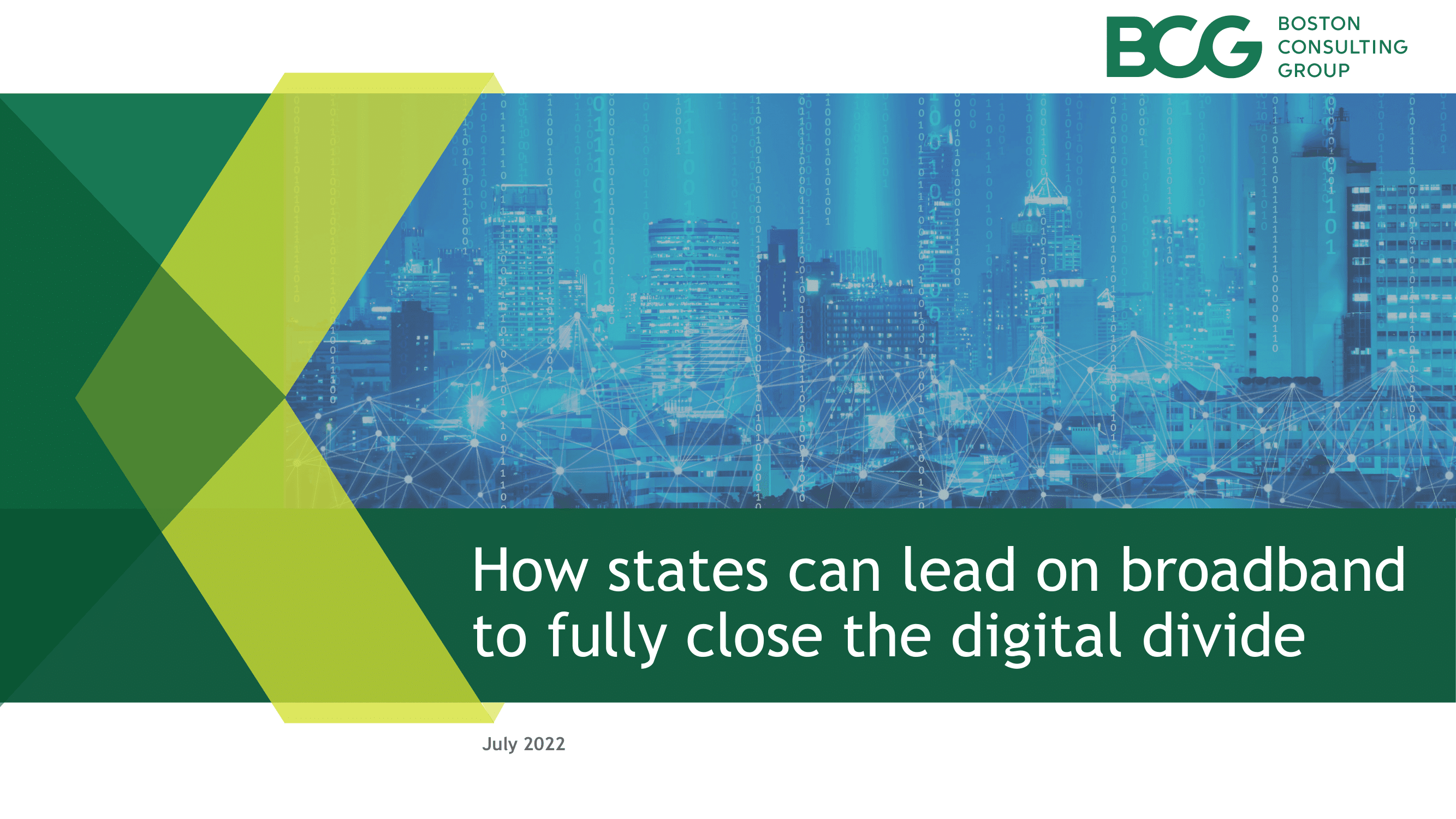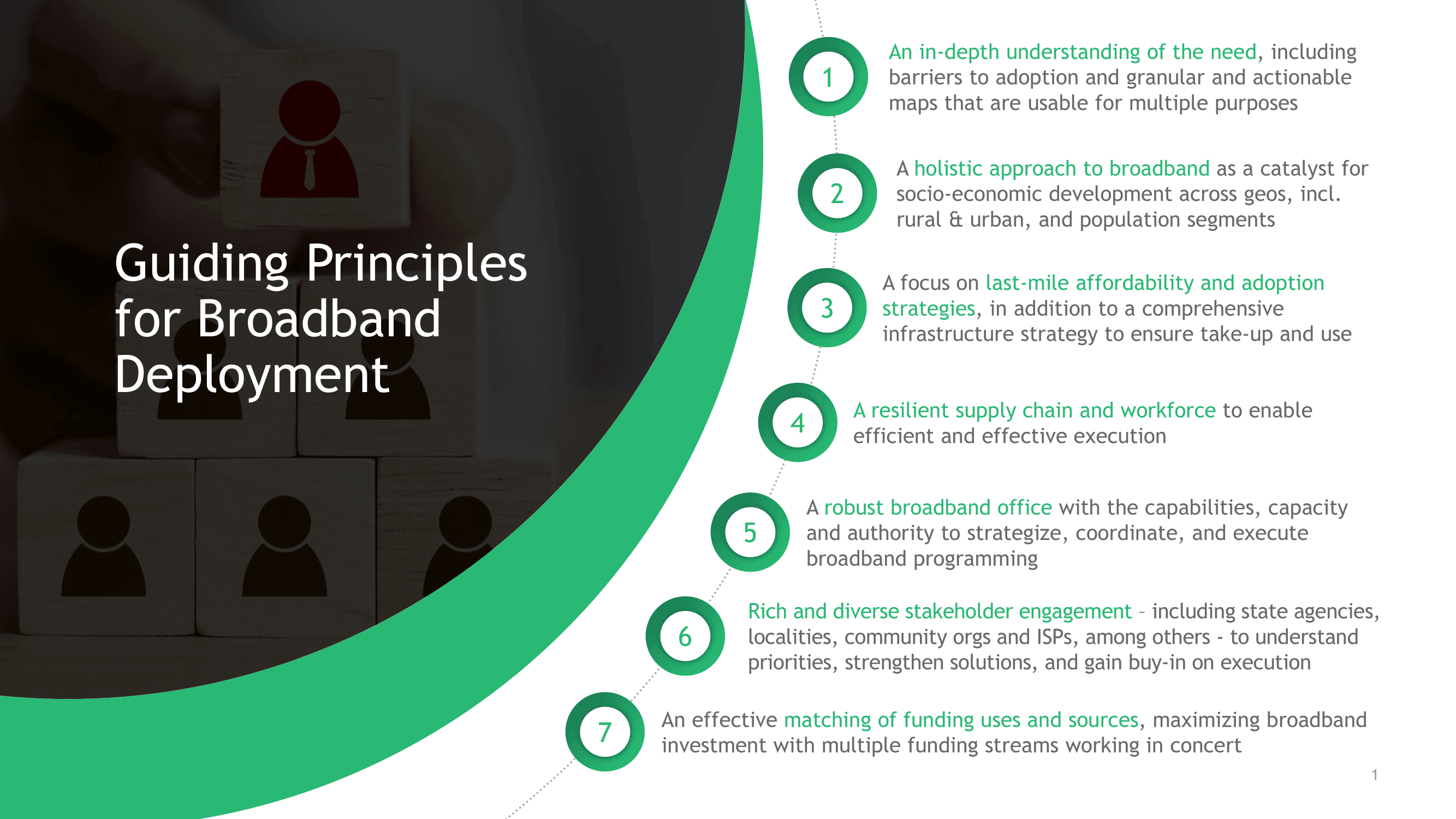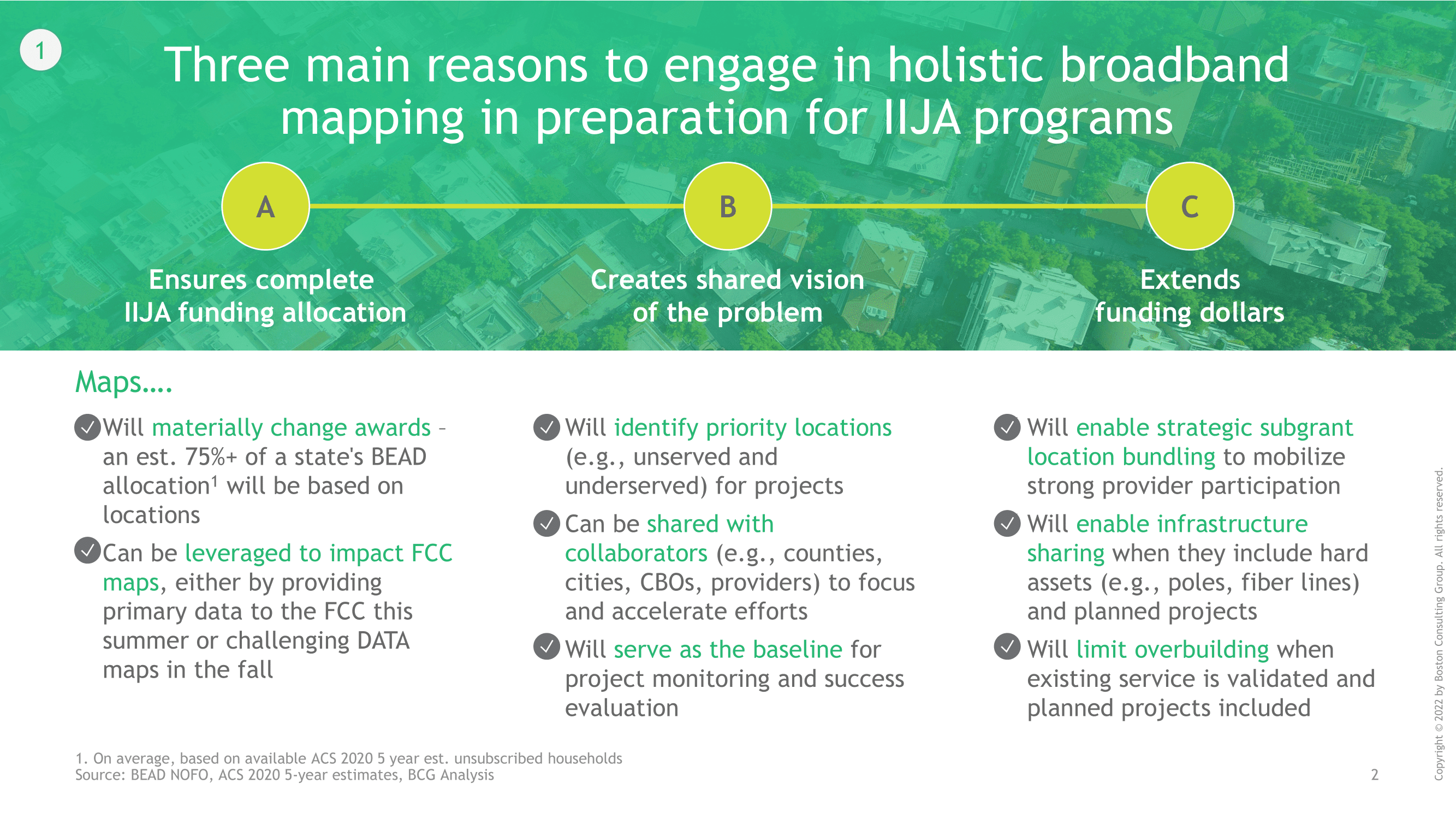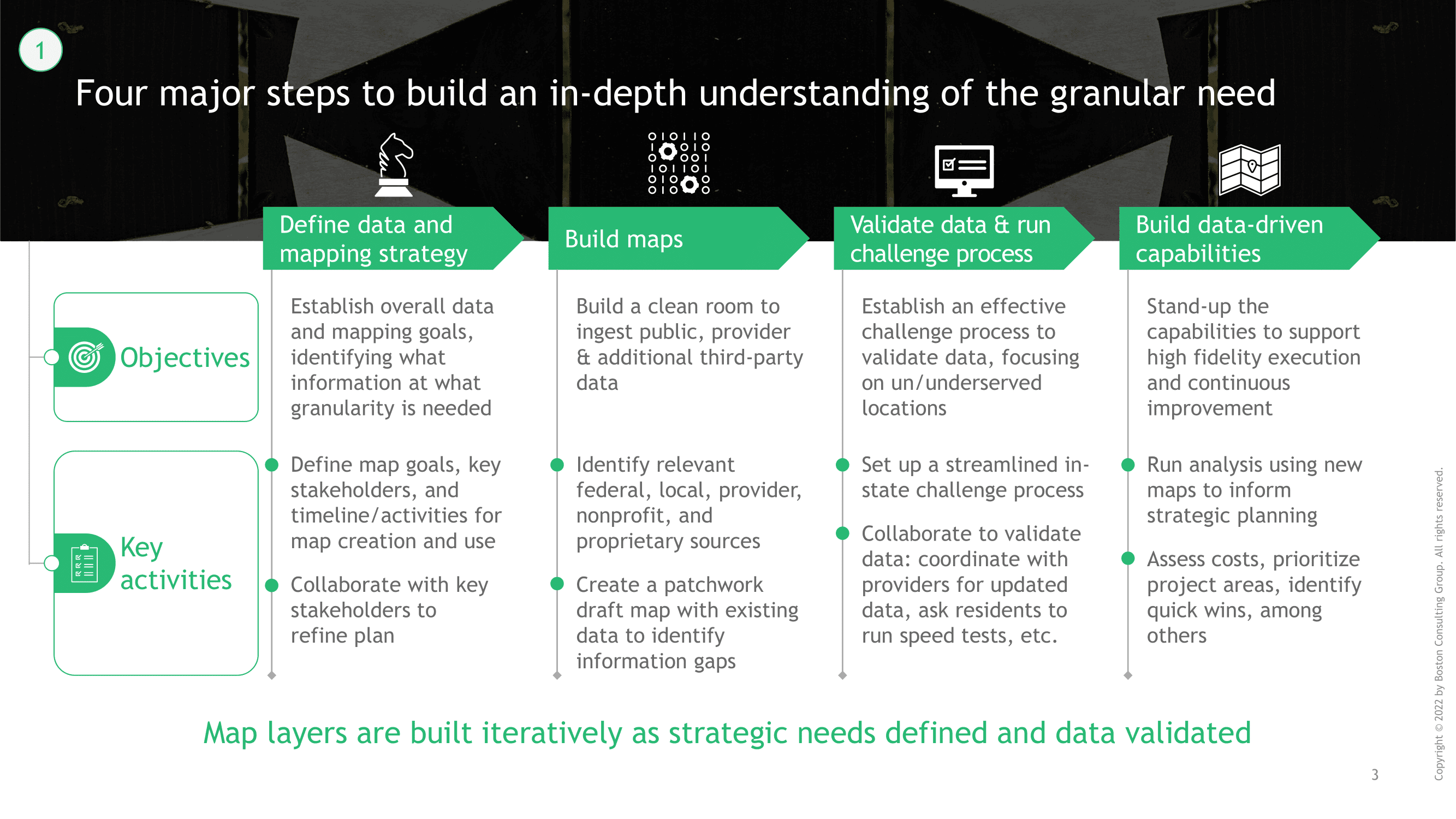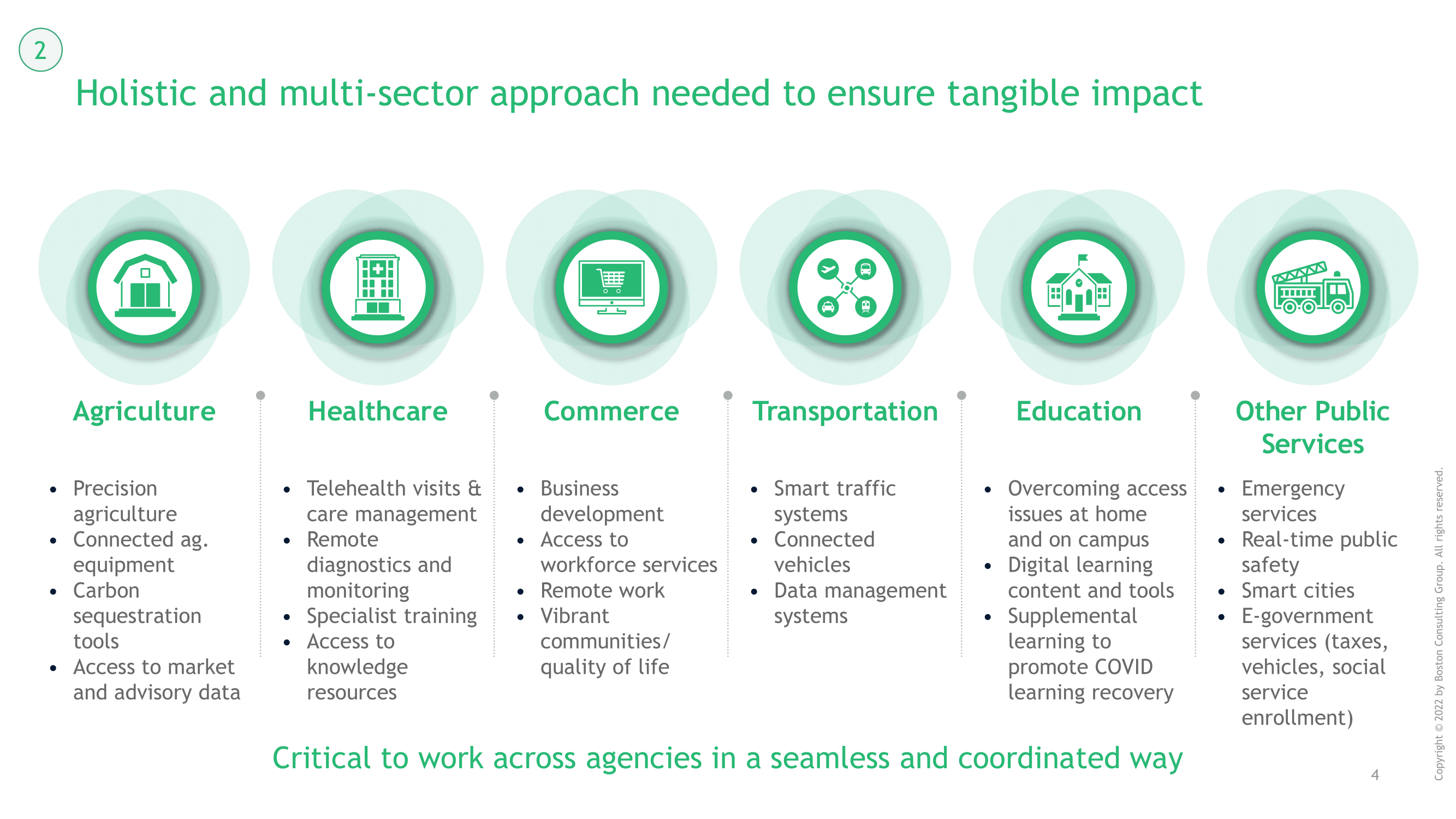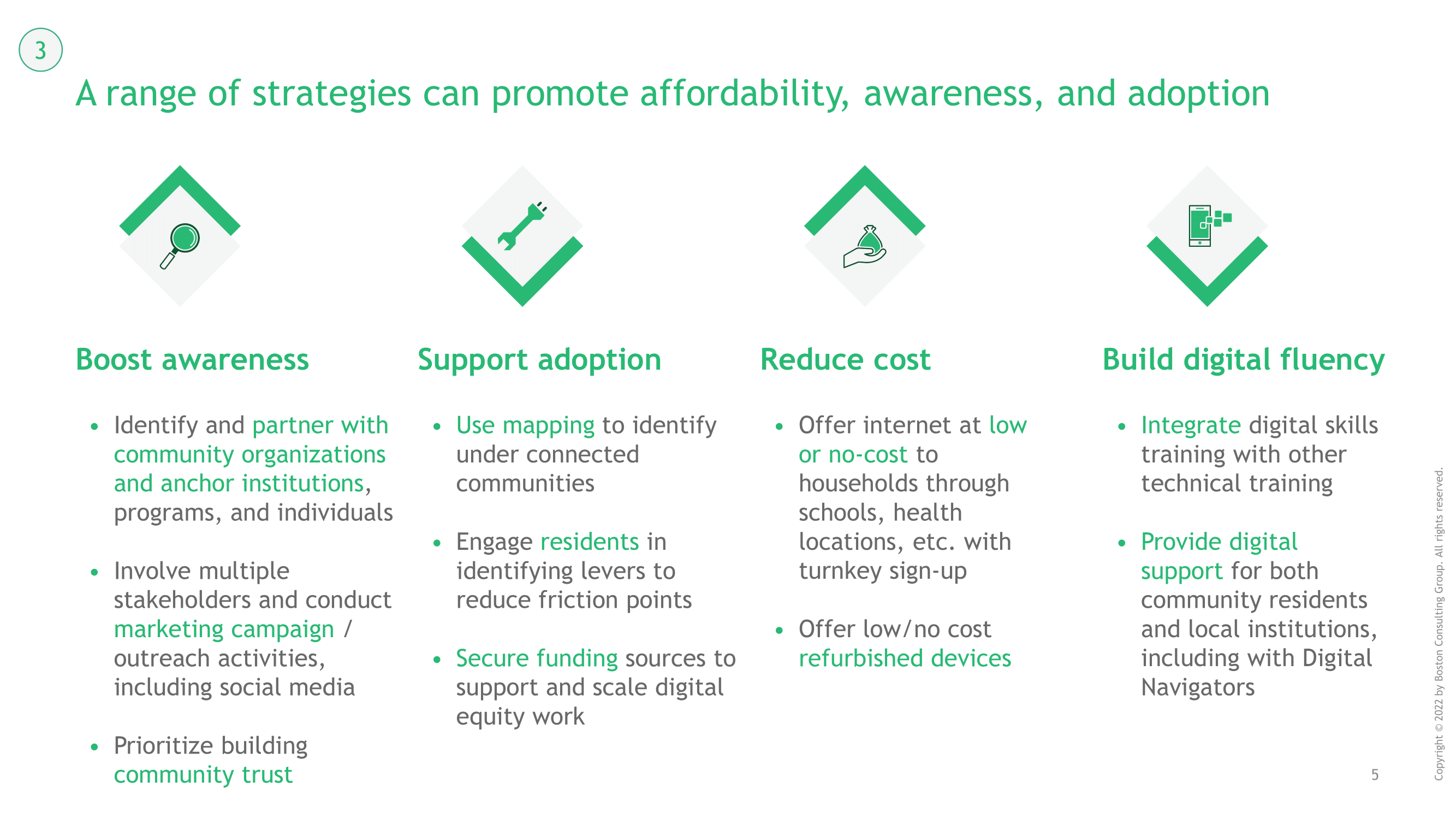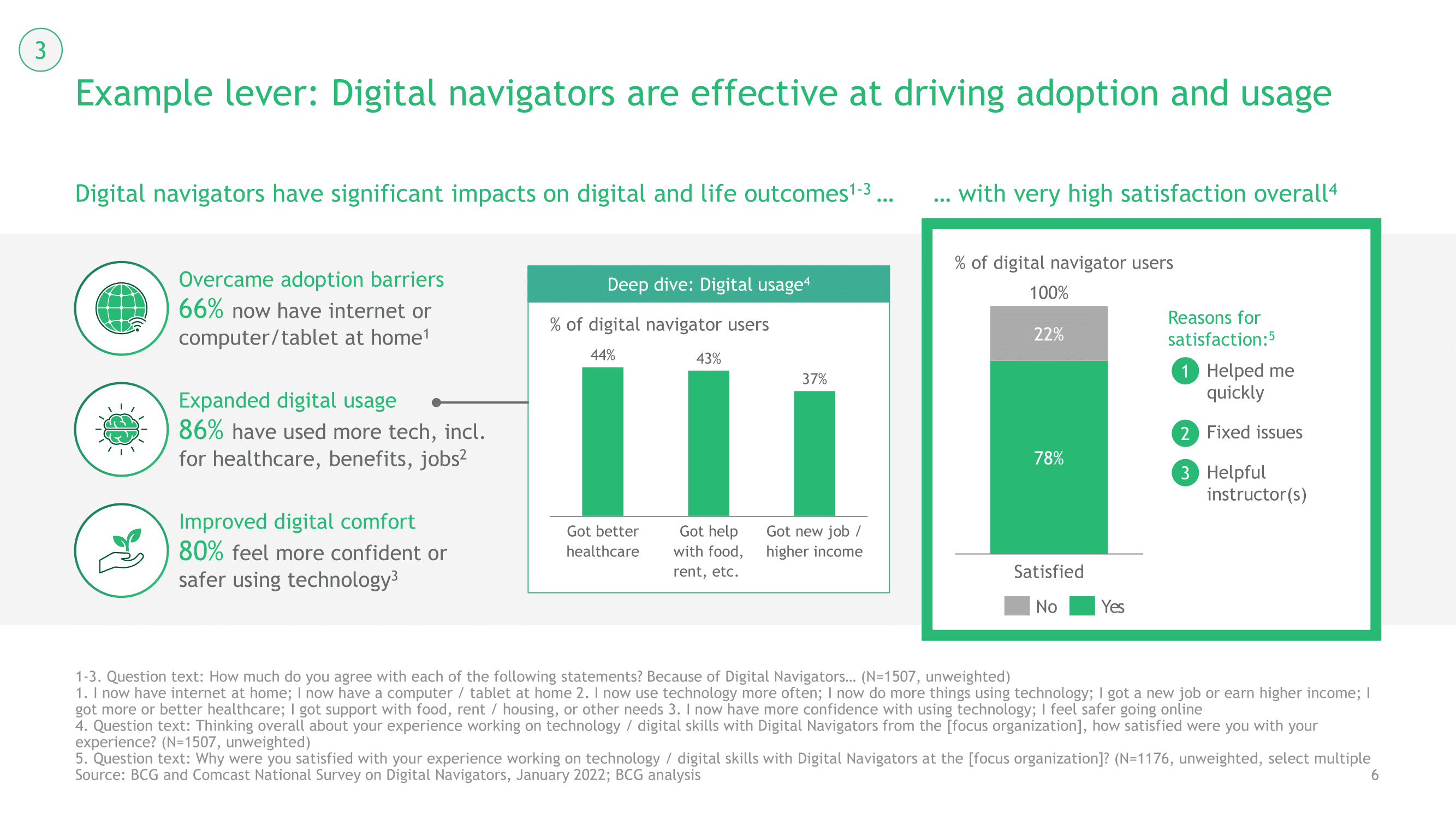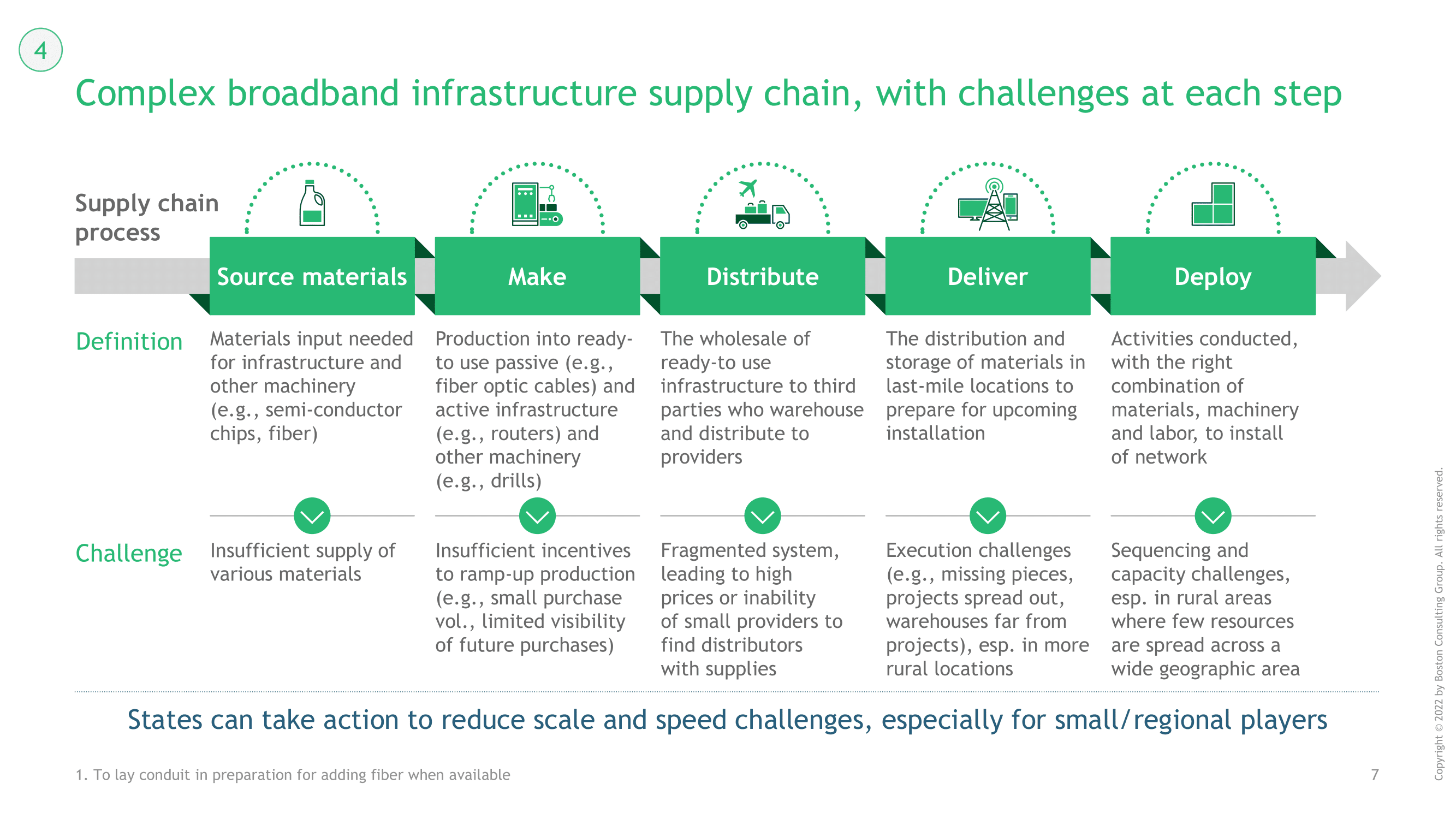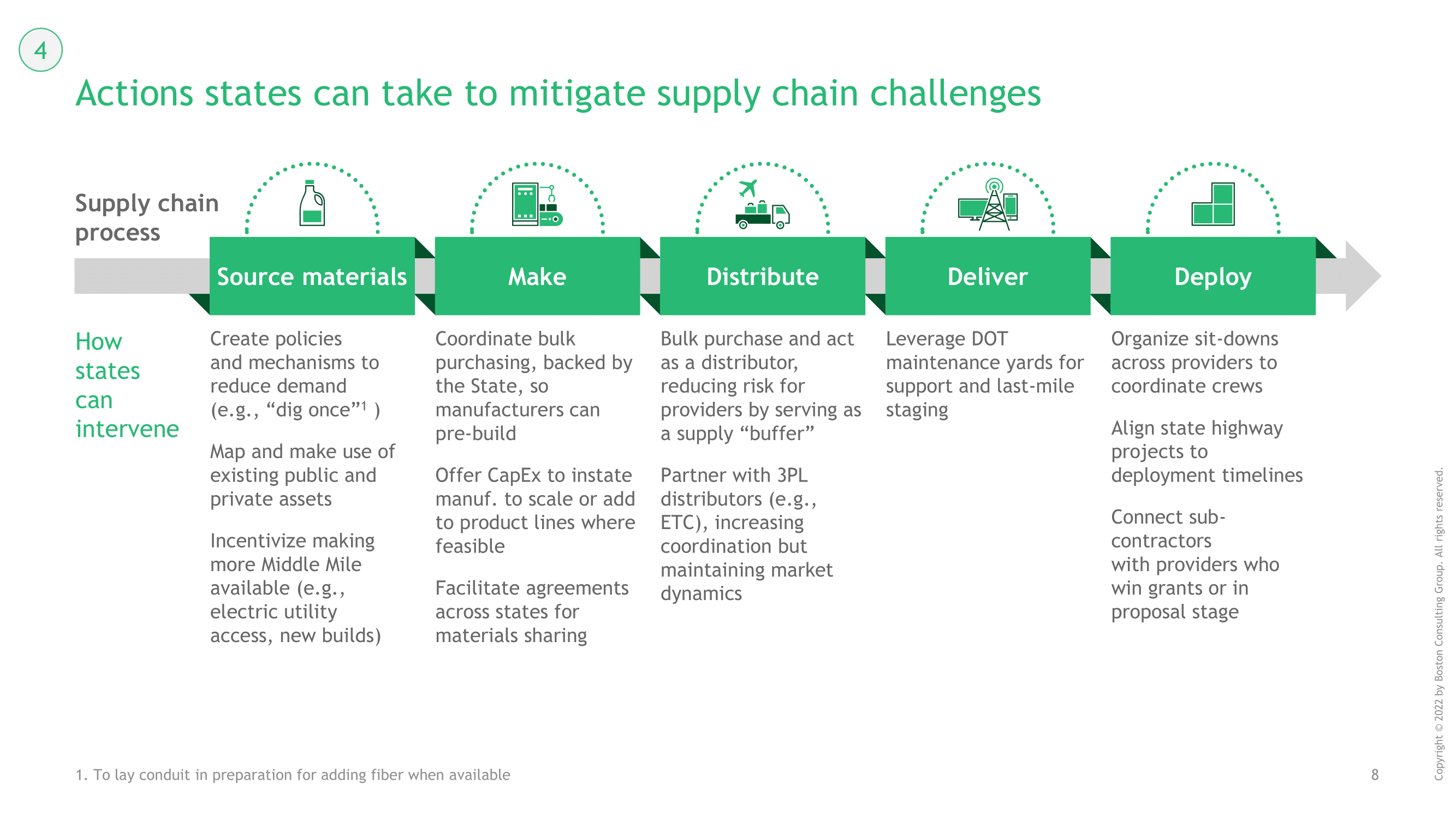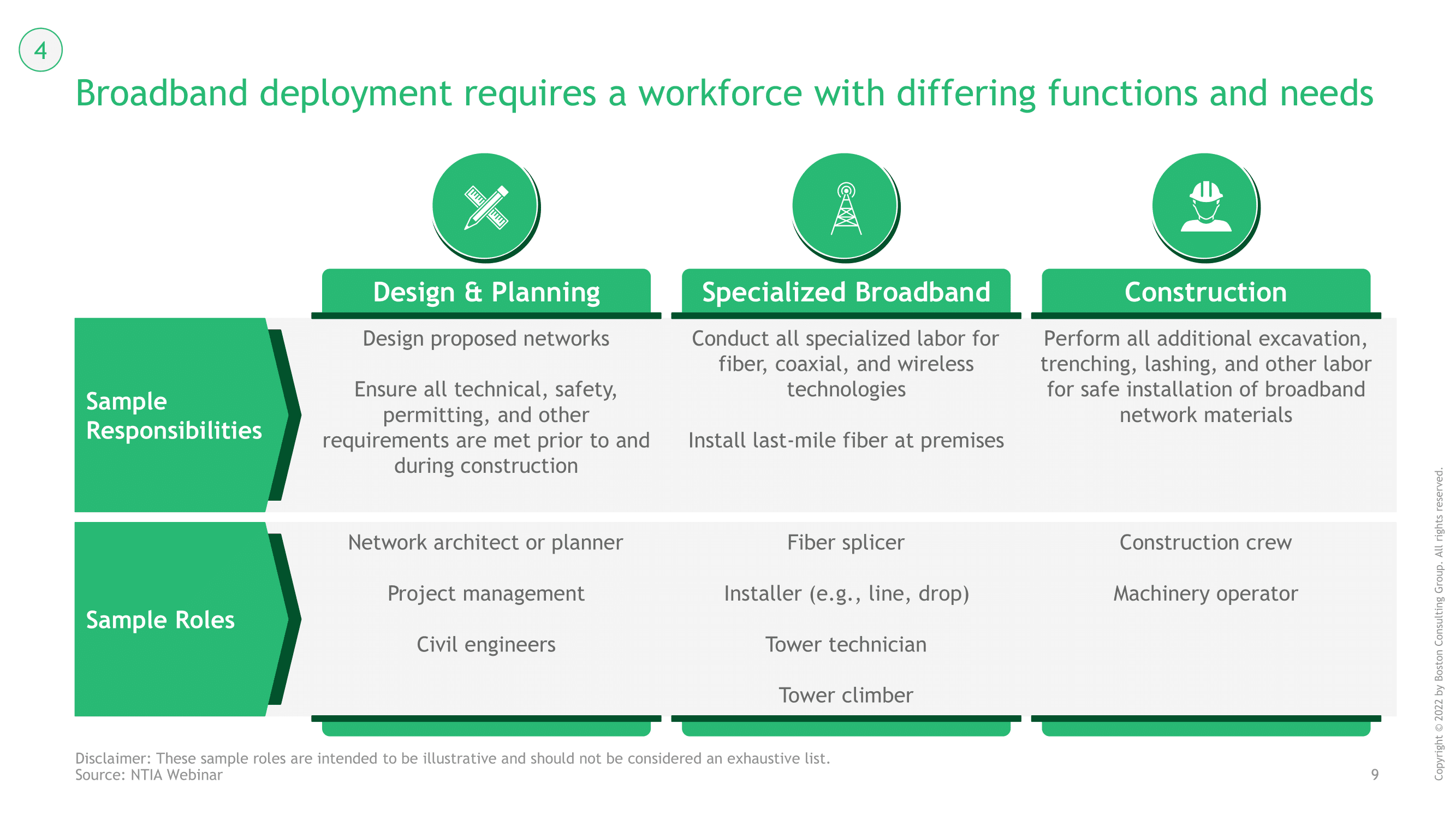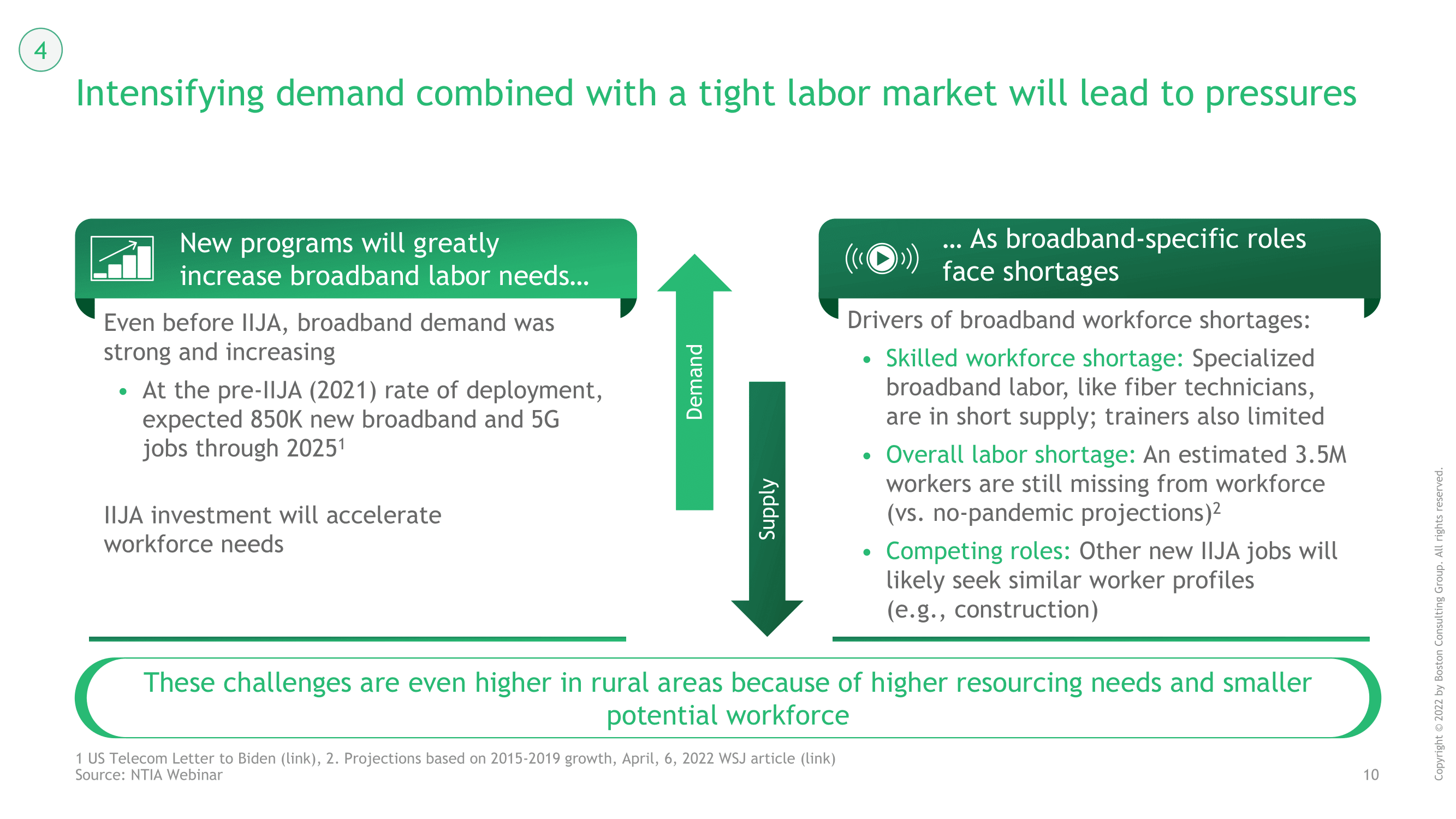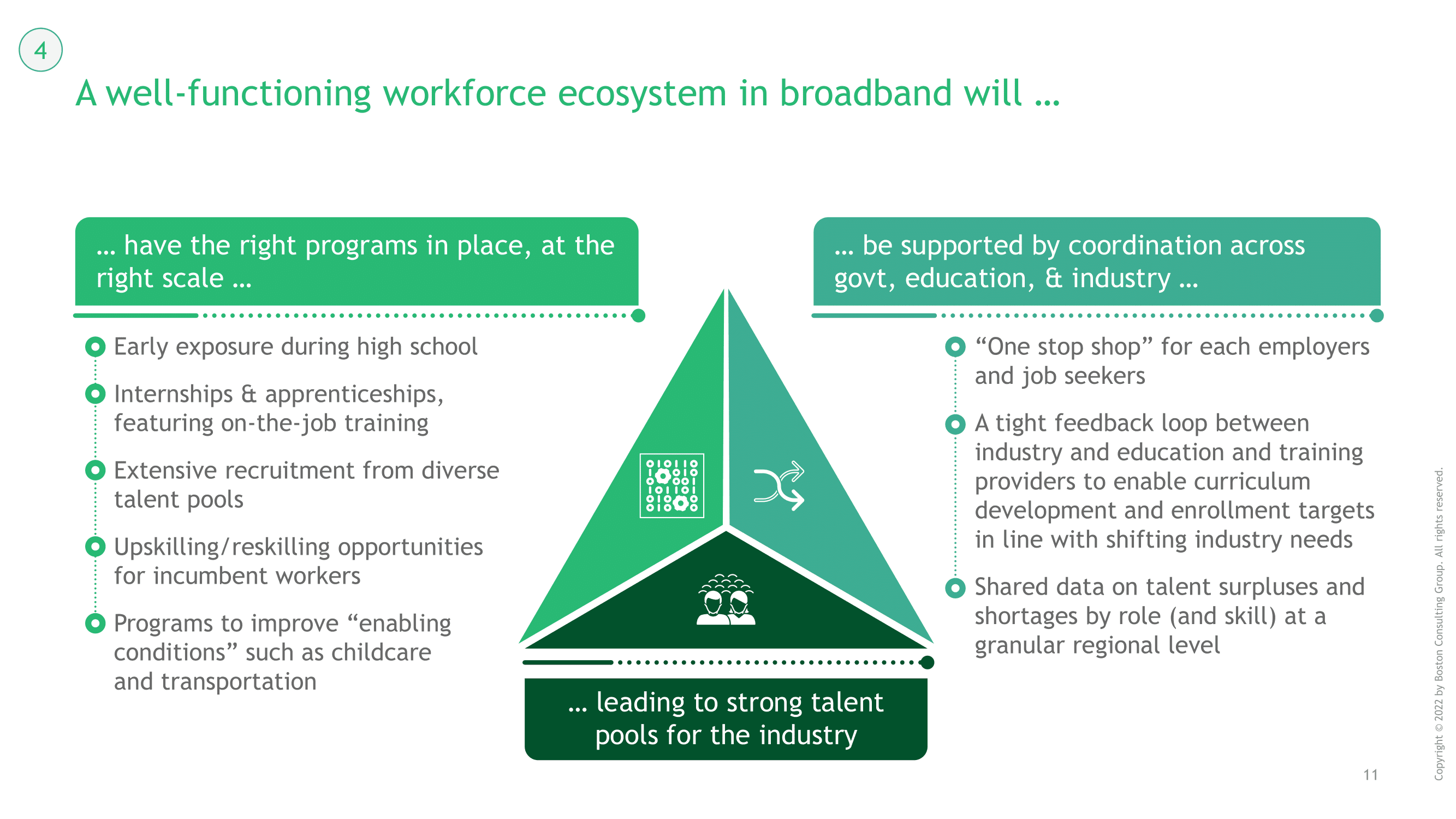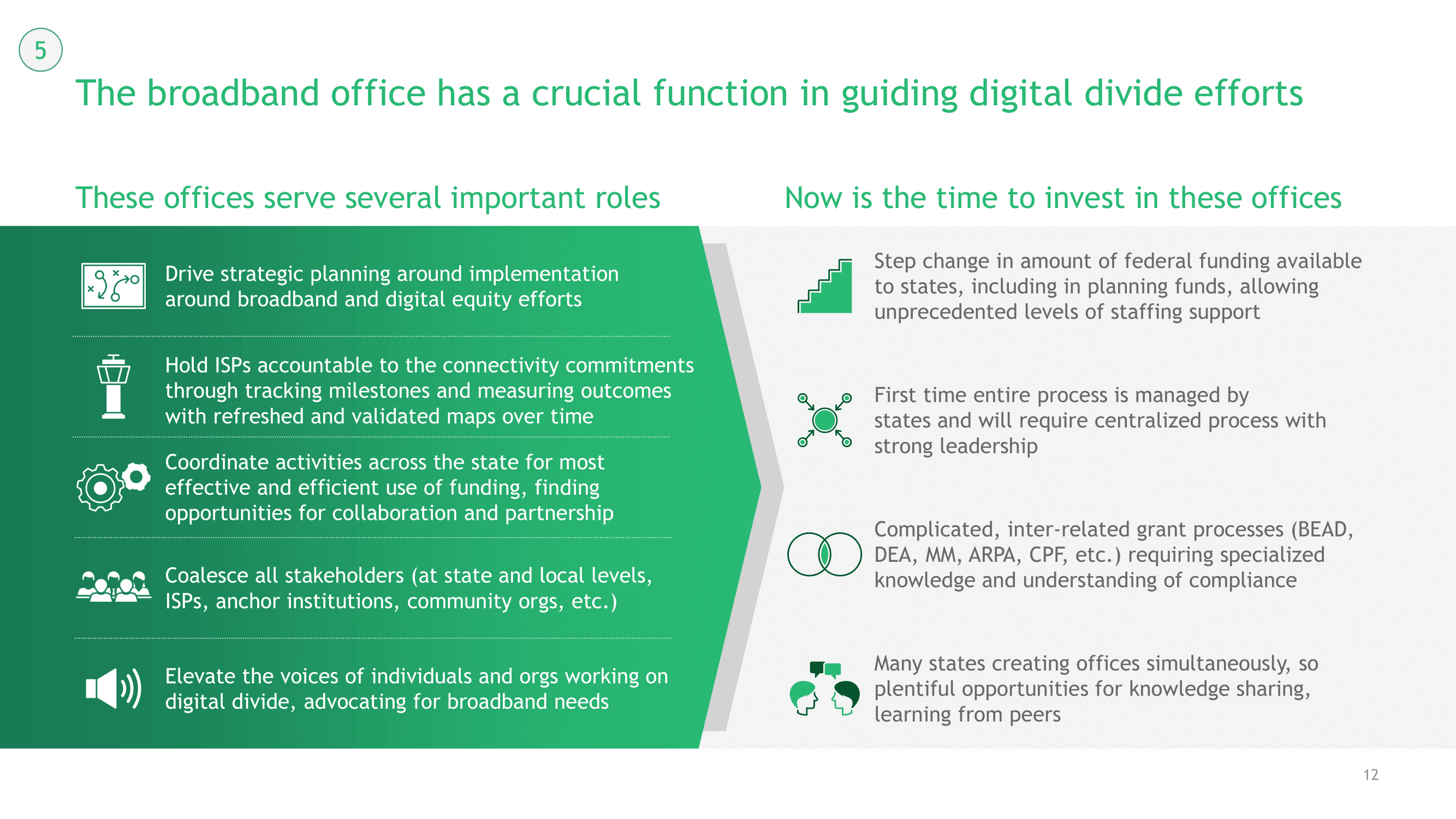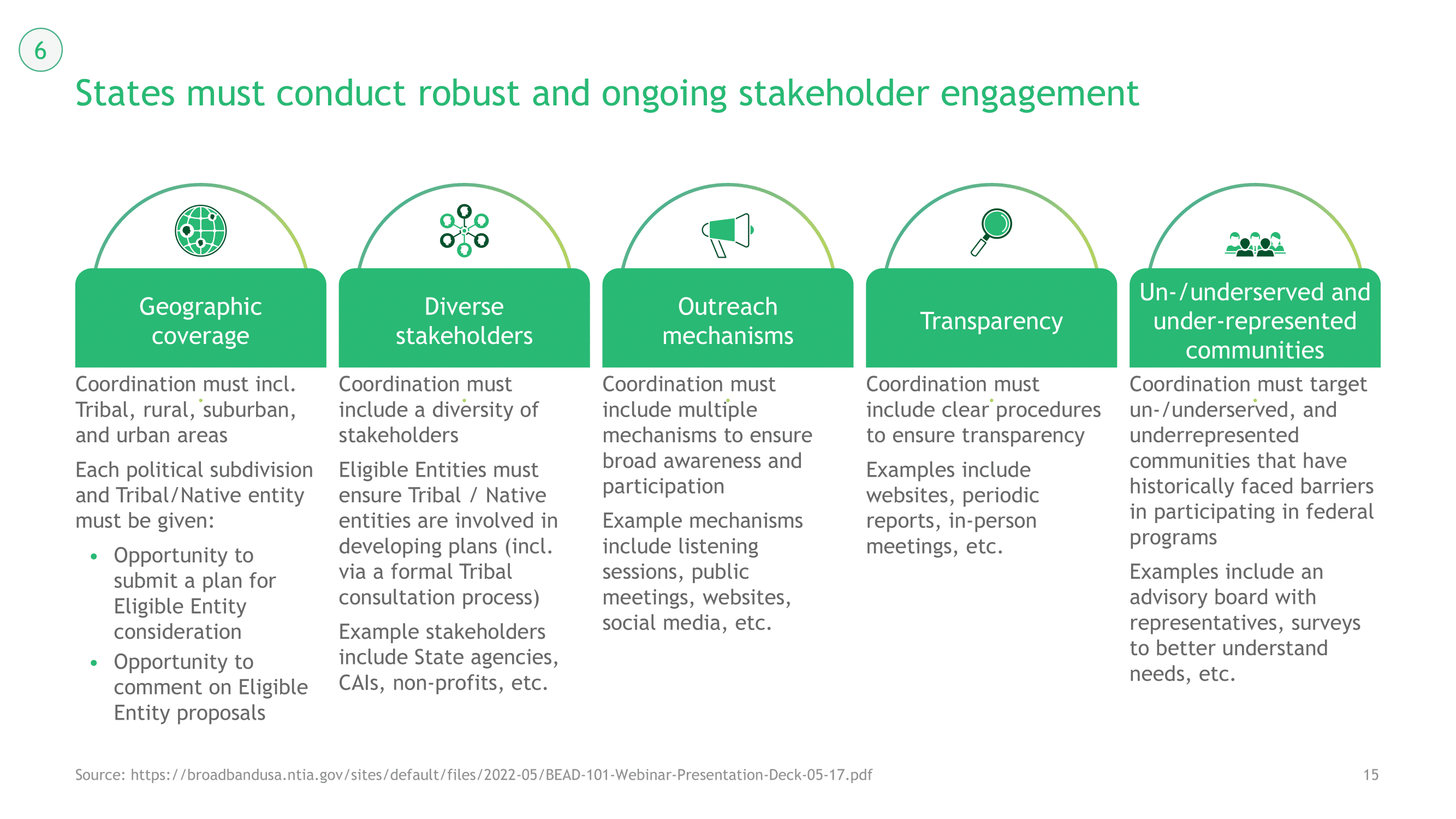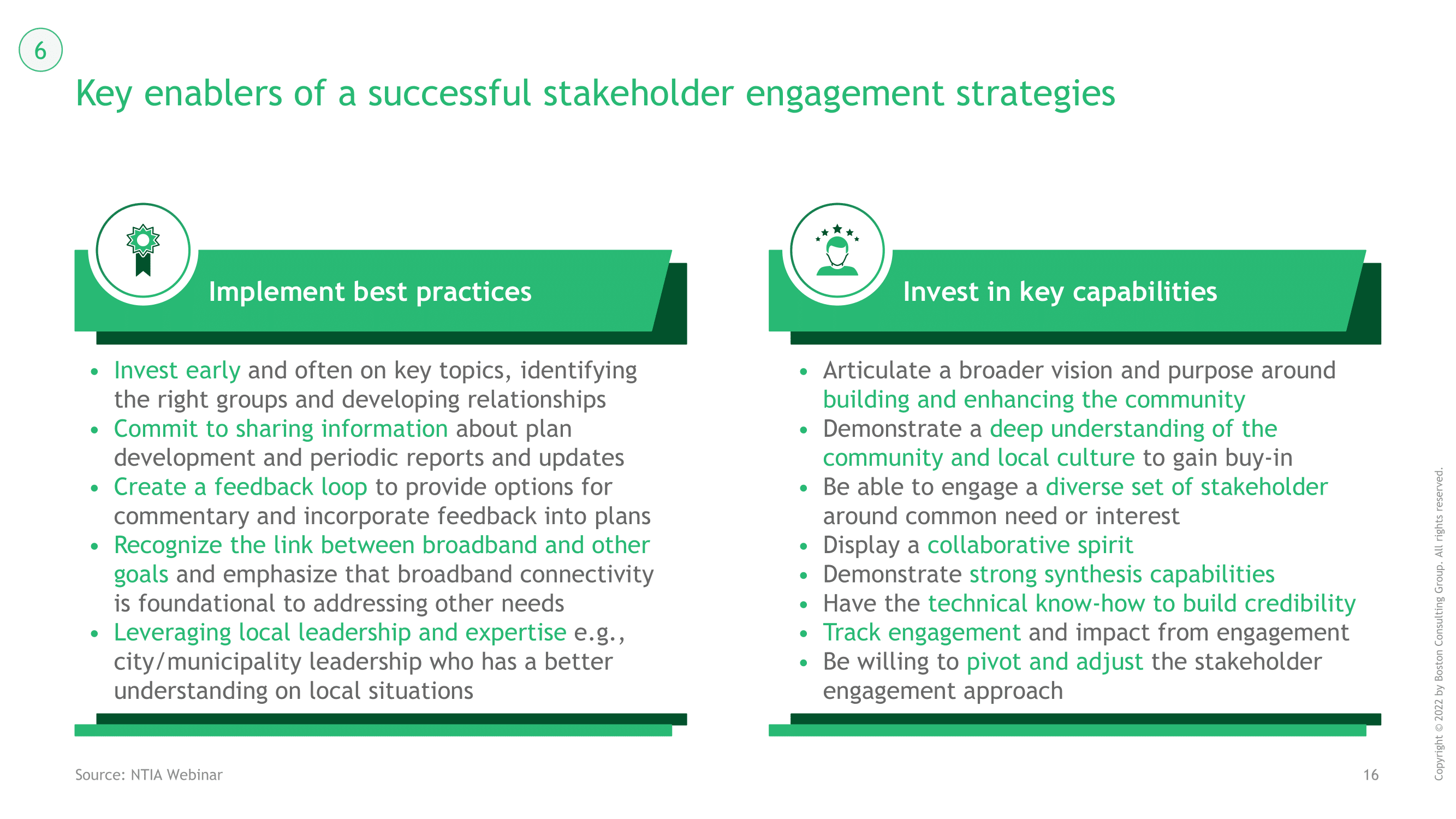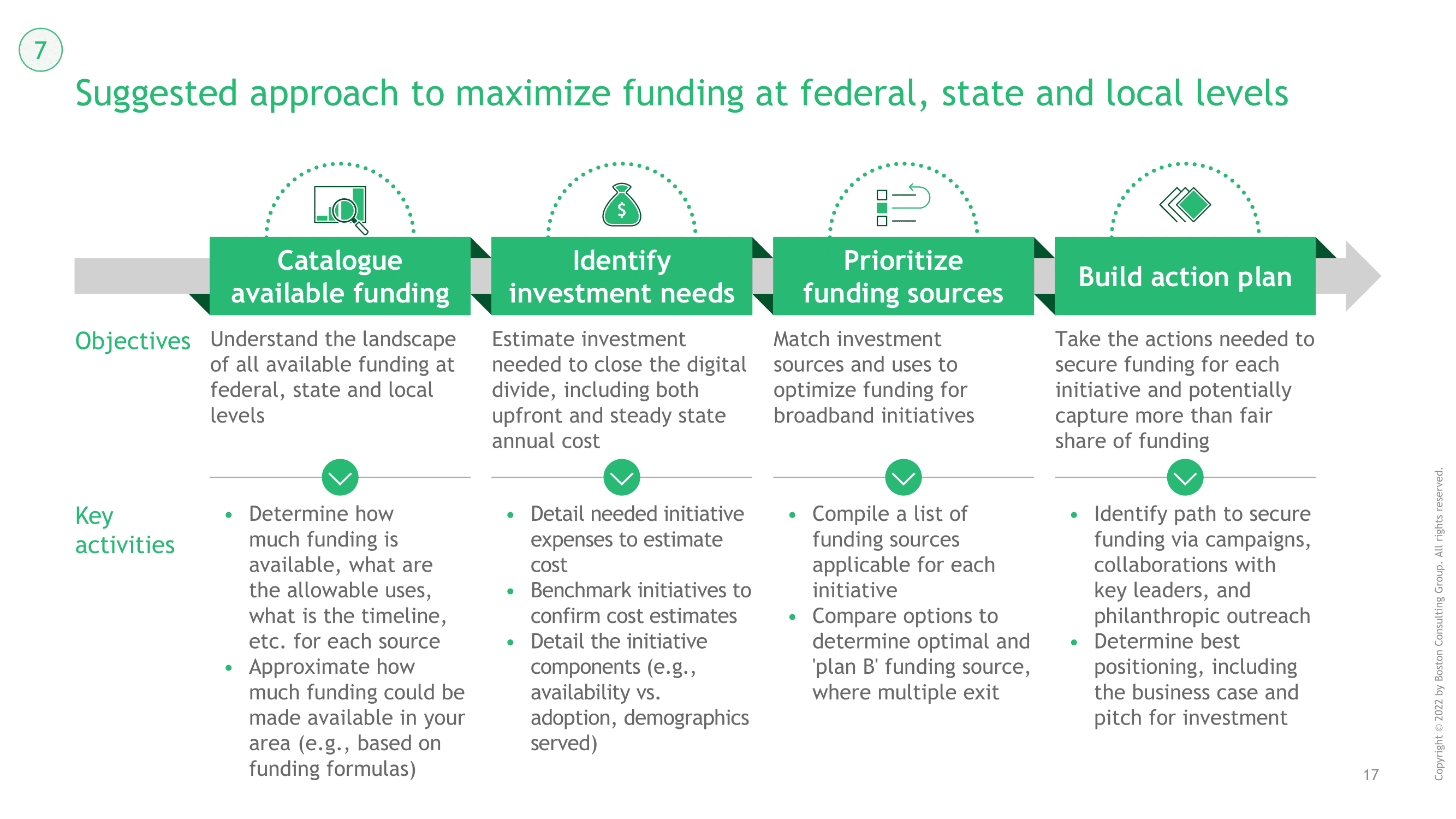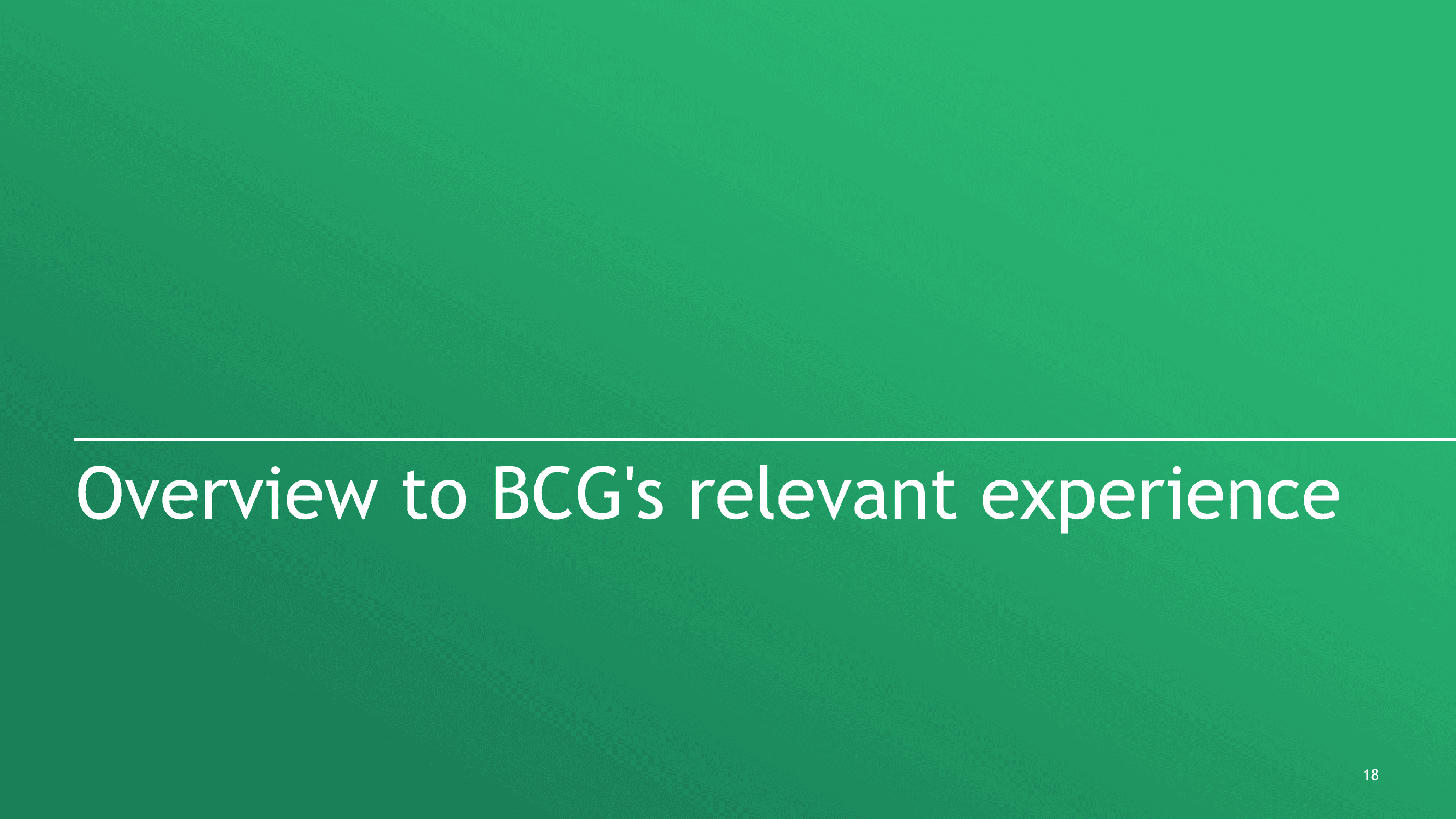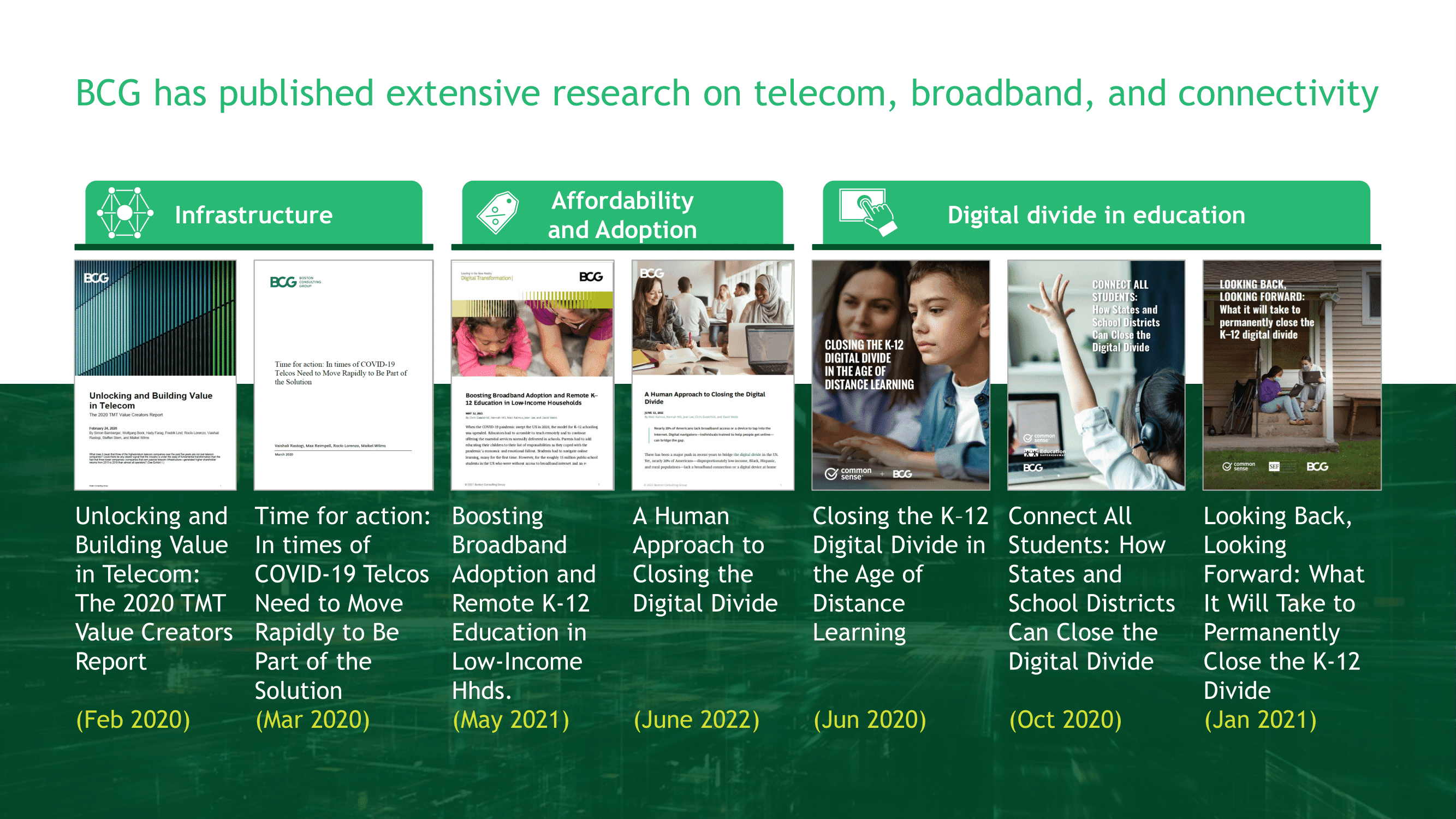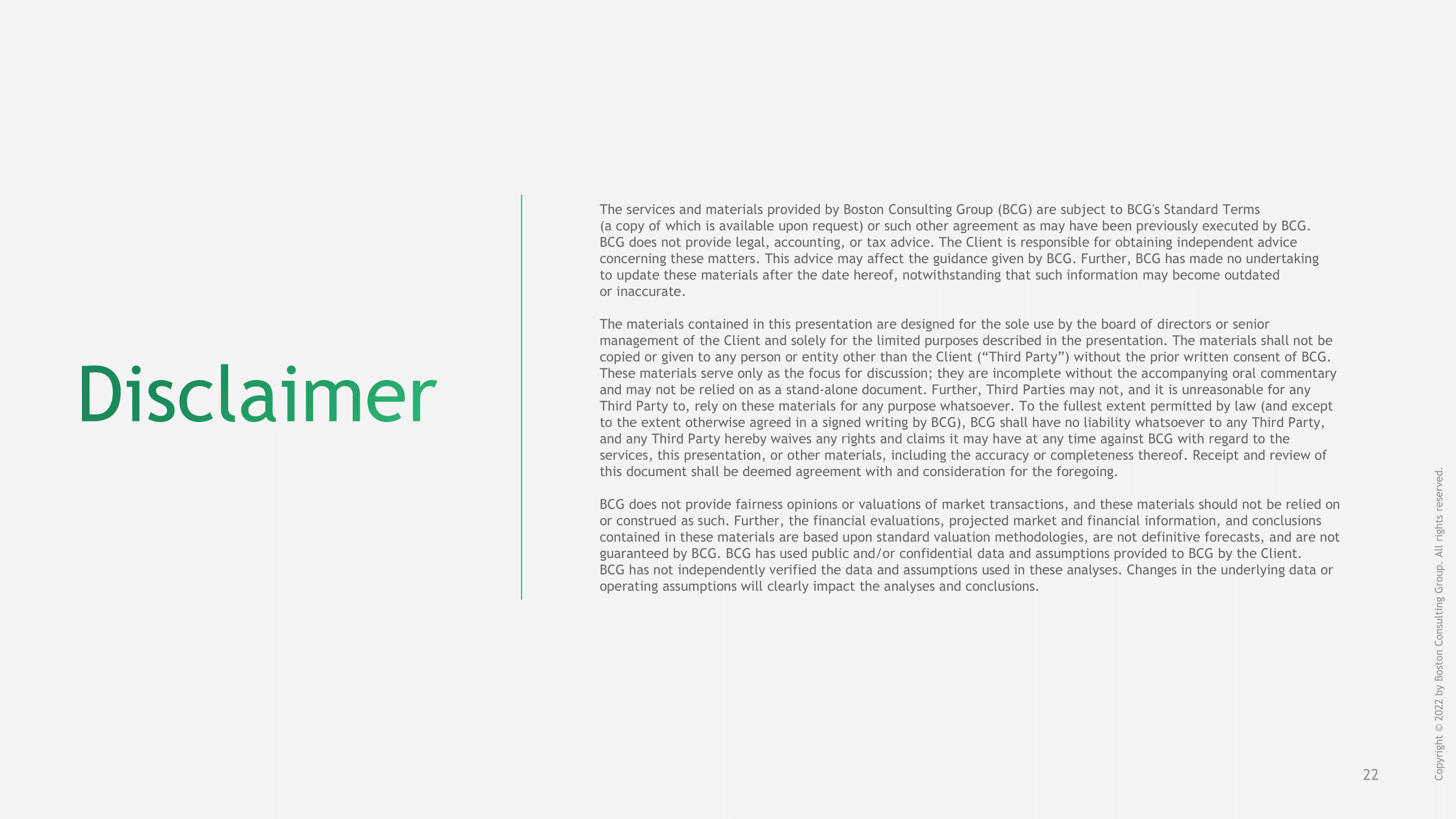Ask Me Anything! With Tejus Kothari

Jul 29, 2022
About Our Distinguished Guest
Tejus is an expert in education, employment, and welfare and holds a Bachelor's of Science in civil engineering from MIT and a Master's in City Planning from the same.
Event Transcript
Benjamin Kahn: Hi everybody, my name is Benjamin Kahn. I'll be hosting today's Broadband Money Ask Me Anything with our guest Tejus Kolthari, sorry Tejus. Tejus is a Managing Director and Partner with the Boston Consulting Group, and he helps state broadband offices take advantage of the $65 billion that has been made available through the IIJA. Tejus, thank you for joining with us today.
Tejus Kolthari: Yeah, thank you. Great, to be here. A good afternoon to everyone.
Ben: Tejus, I was wondering if you could talk to us a little bit about... We have this PowerPoint here if you wanna launch into that and we can get into it.
Tejus: Sure. Happy to get started here. So just by way of brief intro, I'm a Managing Director and Partner with BCG, BCG is a broad management consulting firm with a thriving and growing public sector practice. And specifically in the last couple of years, we've been at the fore front with states, with local levels of government, with foundations and a whole host of others on the topic of the digital divide and how to close it, which as we all know, has taken on greater importance given all the impacts from the pandemic, and now at the cusp of a new frontier of significant funding as Ben mentioned coming through the infrastructure bill. We were thrilled to be part of the conversation today and just more broadly thrilled to be a participant in the broadband community. And what I wanna do in the next couple of minutes is share what we see is a set of principals, set of factors as the title on this page articulates, how can states best lead on closing, fully closing the digital divide. And we've identified based on our experience working in this space in the past couple of years seven different factors. I'll thumb through those, these materials are available on the Broadband Money website. I'll thumb through those seven factors and then we'll launch into Q and A, and hopefully this is a very robust and informative discussion.
Tejus: So in terms of the seven factors guiding principles for Broadband deployment specifically for states, I'll run through these one by one briefly. Point one, we see really important for states to get right and by extension, the local levels of government as well, is to truly understand the need. And oftentimes mapping discussions go straight into the infrastructure and availability, and that's important, and we know there's a whole host of efforts right now and processes at the federal level and states taking their approaches and the availability infrastructure component is critical or specifically at the granularity that's needed to drive action. Our push and emphasis, and as we work with clients is to make sure the understanding of the need and mapping efforts also get to affordability, it gets to adoption, identifies barriers and also links to the next point around a holistic approach and understanding from a mapping and geospatial-granular level, we look at some of the services and use cases that we want Broadband to enable, whether that's in education or government services, or job training and workforce development, to the holistic approach point, just understanding where those are happening and what the trend lines are and are the investments actually yielding activity in those areas? And that's a bridge from point 1 to point 2.
Tejus: Broadband as we see it is critical but at the end of the day, it's a means to an end for development on multiple fronts. Whether we're talking about different types of geographies, different population segments, it's a means to an end to open up opportunities for residents. Whether that's from a health standpoint, from an education standpoint, from a job development standpoint. We see lots of applications that are quite critical in agriculture is... That sector under those set of forces related to digital and analytics and the holistic approach of broadband and in some cases for states, how to break down silos across state agencies to really drive impact in these areas. The third point on this list gets to making sure there is a concerted focus on affordability and adoption strategies. We've recently conducted a study on the role of digital navigation programs, which are increasing in frequency, and we're very excited about that development. In our research where we shadowed a set of digital navigator programs and also surveyed recipients to those digital navigation programs, they can drive impact, but not all programs are created equally. And important that strategies that they're focused on take up, focused on leveraging and kind of reducing friction to access the ACP benefit, support from trusted resources and trusted organizations on just navigating kinda step-by step of how to get connected and what to do with that connectivity we see as critical.
Tejus: Point number four, I feel like this one is coming up more and more and more in our discussions. If I look at and just reflect the past month, say, versus six months ago or 12 months ago, on the supply chain and workforce in that supply chain from call it materials, to products, to distribution, to the storage step, and managing inventory, and workforce, the personnel across different labor categories that are needed, there's a lot of constraints and a lot of forces in play on both of these that are, call it raising the level of difficulty for states in order to deploy Broadband investment. And I suspect we'll talk more about supply chain and workforce later. The fifth point for states in particular, it's absolutely critical that there's a robust broadband office that helps with capabilities, that helps with capacity, it helps with coordination, it helps with stakeholder engagement, it drives the investment of funds from the various federal programs, and states from what we see are in very different places here, there are a handful of states that have been at this for years, more than a decade with very strong broadband offices that are upraised to have the capacity to make use of the federal resources and other states in their journey, they're getting started, but that might be a few years in.
Tejus: I think regardless of that starting point, we're on the cusp of a new day with the amount of funding available, and whether states advanced in their journey or early in their journey, ensuring that the broadband office is set up, appropriately resourced in order to drive efforts is critical. Point six on stakeholder engagement, and specifically two fronts to this all highlight or three fronts actually, one is trusted community organizations and local levels of government that are closer to the boots on the ground, really important that there's diverse stakeholder engagement methods to loop them in into various processes and various efforts. The second is with the ISP landscape, whether it's large firms, smaller firms, providers in the middle, for state broadband offices to have a productive, healthy two-way channel with ISPs, there's open dialogue in terms of what's needed each way and ongoing ways to measure progress and ensure accountability for funds that are getting invested. And then the third front with state agencies, whether that's an education agency or workforce development commerce entity or a public health or healthcare agency bursting through some of the silos that can be typical in government, given the role back to point two, one and two, importance of some of these use cases and what broadband enables.
Tejus: And then the last point is around funding, and a few different angles here we see as important, one is ensuring that states are maximizing the funding that they are able to access from public sources, in addition, how to set up constructs that maximize private investment into broadband and then lastly, making sure that there's an effective matching of those funding sources with uses and ensuring that no dollar is wasted and states are maximizing the amount of funding that they have available for investment. So those are the seven factors, the slide deck has more details on each, not planning to do a flip right now, I'll pause it there and Ben, over to you with any questions or follow-ups.
Ben: Yeah, great. And Tejus, this is a really fantastic document, it's a really great framework of how to look at this issue in its entirety, and I just know that if we try to go through one by one, it's not gonna work because these all collate so well with each other. And so we're probably just gonna flow from one thing to another, but the place that I wanna start with you is this thing here at the top where you talk about... And once again, they collate really well, so will go to those first two points, identifying groups that need help, and the holistic aspect. This is kind of a two-part question. First, how do you identify those groups, and then how do you help them holistically, how do you look at the issue holistically with them?
Tejus: Yeah, so there's two different angles on the whole holistic front, one is at the, call it government and leadership level, and this is in the category of, I think the obvious, but what are the types of uses we want broadband to enable, so whether that's around closing the homework gap or in particular in rural areas, but also seeing it in urban areas in the healthcare realm of greater access to health care services, to behavioral and mental health supports, access to job training programs and workforce development programs, in some states, this is gonna be more important than others, but for the agriculture economy, more and more of the value chain and just how the agriculture industry works is driven by a very digital and data-driven environment.
Tejus: So, you can go on and on that list there are similarities in states, there's gonna be some differences that are specific to states, what are those most valuable use cases you want broadband to enable, then working with those ecosystems, take education as an example, most states you're gonna have a state education agency that oversees K-12 education, some states there's gonna be a very strong public university system or a community college system, other states, that's gonna be more decentralized, individually by domain, education, health, workforce development, and engaging with relevant leaders, both in the public sector as well as in the private sector and social sectors where that's relevant on what are the ways we just reduce friction once someone has connectivity to get access to resources and services that lead to impact.
Tejus: So that's one angle, call it like the higher level kind of ecosystem in these different areas and making that to a broadband office. I think there's been a second level that is, call it coming from the ground up and leveraging data, whether it's... And getting creative about data. Sure, census data provides a moment of time and can help identify specific census tracks and block groups where there might be gaps that are more prevalent in one area versus another, but then integrating with data sets that do reside within the education agency, or do reside within healthcare systems to be very targeted on where focus is needed.
Tejus: And it's one of the things we've seen, I think there's some parallel with how states have managed through the COVID 19 pandemic specifically on testing and vaccinations and taking the very geo-targeted approach noticing, "Okay, we look at these census tracts that have similar demographics, but in one place, there's a much higher vaccination uptake, okay, let's actually make a few phone calls and get on the ground and understand what's going on, and are there lessons to be learned?" I think we can apply a similar frame of thinking as it relates to broadband out here, there's a place where take-up, ACP penetration is higher or more residents are accessing government services through digital ways. What can we learn about that and what are the learnings that we can then apply in other places, coming at it from the bottom up and doing so in a data driven way.
Ben: I wanna circle back to the first aspect that you mentioned, the higher level kind of way of looking at this. So one of the issues that we constantly being heard discussed on the news, we hear are being discussed in the media, like at every level, we hear supply chains, we hear workforce, especially as we've kind of weathered the COVID 19 pandemic, those that are at the forefront of everyone's mind. But a lot of people think about at the federal level, or what kind of actions is our government engaging with other countries that we can... Supply chains, workforce trends. I'm really curious about your perspective in the lessons that BCG has to offer on localities with the actions that they've taken and found to be successful, and at the state level, I'm wondering if you can kind of provide some insight on that.
Tejus: Yeah, happy to. And in some sense, the broadband challenges on supply chain and workforce they are, yes, here and now issues, but there's also a projection, fast forward 12 months, 24 months, and we've got a set of estimates on workforce, for example, of just what's the amount of people that are gonna be needed for different categories of positions and how does that look by states? And you look at those numbers and just raises a question, especially given the type of labor market that exists today, where are we gonna source those people from? What are the talent pipelines? What are the up-skilling and re-skilling and maybe adjacent roles or individuals that might be unemployed or underemployed, and how we get them into positions, there's a real opportunity that can be win win on so many levels, by zeroing in on workforce, I think there are some parallel efforts from states that we've seen, we've been a part of taking a pro-active approach, working with industry and a cross-section of employers and being very specific about what are the needs that we have, what are the needs we have in 2023? What are the needs we have in 2024? What are the needs we have in 2025?
Tejus: What positions and how do we map that to skills? We've got, call it the demand curve that is actionable on exactly what our workforce needs are and we can imagine that type of process playing out in the broadband industry, in parallel engaging education and training providers for those roles that require some type of certificate program or just skill development at the end of the day, how do we make sure we have those programs, those programs are accessible, they're affordable or even no cost to the student going through them, they're accessible in different parts of the state and just make sure check, check, we got all of that, consider that part of the supply side.
Tejus: A third component on the workforce side is then how do we... And especially as it relates to infrastructure and more broadly, we think this is really important, a set of job fields that have not had the highest levels of diversity, whether we look at it from the gender side or a racial side, how do we think very creatively and holistically about different population segments that would be great fits for these roles, that a little bit of extra attention and action is needed to reach them, kinda meet them where they're at, and provide those pathways into those education and training programs, into those jobs and have a holistic approach to recruitment that reaches a diverse set of people, we think that type of call it formula or playbook for infrastructure more broadly but also for broadband is something that every state, every local level of government should be doing in some form.
Ben: So I don't think it's a hot take to say that there are some communities across the United States that for one reason or another, don't trust the federal government, don't trust their state governments, and have otherwise been in some ways disenfranchised. And so how do you reach out to some of those particularly difficult to reach communities that may not have a lot of faith in the system, so to speak, how do you engage with them so you can determine what their needs are and get them engaged in the workforce?
Tejus: Yeah, great, great question. And I'll actually pull it from some of the insights on the work we did to better understand digital navigator programs, and one of the things we asked participants is, "How did you get engaged in this? How did you find out?" And the data points are roughly a third of participants, it was an organization, a not-for-profit or a library that they already had a relationship with, it wasn't government coming to them necessarily, or maybe it was a very local level of a government agency, in a lot of cases, it was different not-for-profits and different libraries and education systems, that was a third, another third was it was a, call it recommendation or referral, not the word they necessarily use but, "A friend told me about it, a family member told me about it."
Tejus: And the grassroots component of this is important and I think for the, to your point on just the hot button issue, government can't be the only front door, can't be the primary front door. It needs partners with anchor organizations, anchor institutions and communities. It needs partners with not-for-profits. We've seen some states, Alabama and Texas as two examples of really using schools, K12 schools as a way to drive low cost or no cost internet connectivity options and making it as frictionless as possible for students and their families to sign up and really thinking about the multiple channels that have to come together because to your point, if it's government only, it's gonna tune out sizable segments of the population.
Ben: So how can states... What advice would you have for states and people who are in this industry to go about facilitating these kind of public, private relationships and determining, this is something we've discussed about at length and broadband money and broadband breakfast aside, how do you determine what a good fit is? How do you know what types of institutions you should be working with and identifying that perfect partnership?
Tejus: Yeah. In some ways, and maybe this will be a unsatisfying answer, but local context matters a ton. And the approach that might work in one county or community, may not be the right approach for another county or community that might be right next door or on paper look like they're very similar in terms of demographics. And the channel that states have with counties and with even communities is really important to understand the local context in those places. So if we think about what that means from a capability standpoint, state broadband offices, we see one of their critical roles is to develop the local and community engagement in someone, in a team of people that their job is, they wake up each and every day thinking through, "Okay... " Yeah, I was born and raised in state of Iowa, 99 counties.
Tejus: They're thinking through, for each of those counties and communities in all of those counties, what's that local context mapping of the different types of organizations that will be helpful to achieve broadband goals, proactively feet on the ground, engaging people proactively inviting them in as thought partners, inviting them in co-design processes. And I don't, this isn't the type of work that you can just build an app or build a software platform and significantly scale and reach every single of the 99 counties in Iowa and you've got it solved. It takes, real, real focus and real attention.
Ben: This is a question from Broadband Money's own Jace.
Tejus: Okay. Thanks, Jace.
Ben: Yeah, name drop. He says, "Tejus, what's the most important thing state broadband directors should know when it comes to the upcoming tsunami about funding opportunities they'll oversee?" So shifting gears a little bit, but still obviously very relevant to the conversation that we're having.
Tejus: Sure. Hard to limit this to one. And Jace will probably give me the critique that you really didn't say one thing, but I'd frame it, effectively getting money out of the door, time is precious for so many reasons and the sooner we can get to impact the better. So how do we accelerate getting money out of the door and states aren't the bottleneck, but doing so in a way that ensures high ROI for those dollars? And defining the R part of ROI holistically and tying back to actually some of the things we're talking about earlier, access to job training programs and completion and successful outcomes, placement outcomes as a result of that, access to government services and social services, access to health support. So okay, that's... So how we wanna measure the R, how do we wanna optimize that relative to the amount that's investable?
Tejus: We need to make sure we're directing dollars to where they're most needed, we need to make sure we're not overbuilding, we need to make sure we're not overpaying, we need to make sure we are catalyzing, matching private sector investment, we need to make sure we're catalyzing a competitive landscape across ISPs. All of those things kind of feed into it and this is the critique. I didn't just say one thing, but I think it can be a useful frame for how, we need to get money out of the door quickly, but we can't just get money out of the door quickly 'cause then we'll run the risk of without careful thought and planning and kind of the platforms and analytics and capabilities and people to support, we run the risk of wasted investment and wasted resourcing and don't get great return and tangible impact at the end of the day.
Ben: So Drew Clark raised a question that I want to feed you now it's, do state agencies outside of broadband offices appreciate how important broadband is to achieving other state objectives? Ties in a little bit to what you were just saying, but I think this whole approach of this holistic approach, you wanna assume that all your stakeholders are pulling in the same direction and also have a holistic view of the situation. So if you can give us some insight on that, I'd be really curious to hear about what your experiences are like.
Tejus: I would say from our firsthand experience, the intent is almost universally there. The actual lived experience and is action being taken and investment being taken by other agencies in a coordinated way is more mixed. And it can be more mixed for a whole variety of reasons. One of which being, it's a challenging time, it's been a challenging few years in state government like many sectors and imagine running a public health agency, or imagine running an education agency throughout this pandemic, there's just been so many demands placed and overstretched kind of over not enough capacity just in general, so it can make it tough to drive action to my point earlier and effectively mobilizing, but intent, we've almost seen universally there from different agencies in multiple states, we've seen examples and have been part of examples, say education agencies taking a very proactive approach.
Tejus: How do we coordinate, in the early days of the pandemic, how do we coordinate across all of our school districts and in the mad rush and scramble for Chromebooks and hotspots in the summer of 2020, let's actually take advantage of our state-wide scale, coordinate our orders with different providers, helps us get better terms, makes our dollars go further, accelerates kind of the timing of delivery, and we've seen education agencies just take that role on because it was so critical in the months of June, July, August of 2020, when we had good indications that the next school year, a high share of it, or there was certainly the risk at that time, a high share of it would have to be virtual, so we've seen state education agencies do that, we've seen healthcare agencies particularly on mental health and behavioral health and rural health care really drive efforts in those places. So there are countless examples and plenty that we are not even aware of, of great things happening from other agencies, but it's not the case every state, every agency from what we've seen.
Ben: Yeah. So I'll take a quick opportunity to remind our audience that they are welcome and encouraged to drop questions on the page, drop those soon, so I'll be able to ask those questions before we have to let Tejus go. I have another question from Drew where he asks and this is something you've already mentioned a little bit, you've discussed a little bit, but I wanna circle back to what is your view of the digital navigator programs, and are they successful, and if so, how have they been successful?
Tejus: Yeah. The ones we've seen be successful kind of worked through multiple steps, multiple steps, spanning from the start, they are effectively finding the right type of organizations and ultimately individuals to be navigators, and to the point we're talking about a couple of questions ago, trusted organizations that already have a presence in communities you're trying to reach, and individuals that are part of these organizations and being able to loop in those individuals into digital navigation programs and effectively get them up to speed in terms of what it is they need to do in order to be an effective digital navigator, that's one step. I think the second step is making sure there's different profiles of digital navigators.
Tejus: Is there someone that's really there just to troubleshoot, how does someone get signed up or they're really there to figure out and help people they are trying to reach access government services, or access jobs and careers and having the patience and persistence to do that and just thinking about those different types of roles and making sure that the capabilities are there. We'd say third point is around measurement and collecting data on what's happening sort of say in the field, and collecting that data, looking at that data, identifying the patterns, identifying what's working, identify where you might have some things not going according to plan and hitting that back into a process of, "Hey, we might need to make some changes." And being able to do that in terms of weeks and days and weeks, not months and years, if there's any course corrections that are needed.
Tejus: And then the last one would say, and we're excited about the prospects given more funding available for broadband overall is a lot of digital navigator programs are sub-scale and under invested, they show effective outcomes but the ability to actually grow and expand into more neighborhoods, to expand deeper into existing neighborhoods, there's a resource constraint, and from a state perspective, making sure you've got visibility, all the digital navigator programs that are happening in your state and ways to understand which ones are highly effective and then quick ways to support them and growing and scaling and expanding in areas where it makes sense.
Ben: Well, one of the things that you mentioned was that it's difficult to kind of provide a cookie-cutter solution for any of these communities, because every community has their own stakeholders, they have their own unique issues, it has to be addressed on a case by case basis. And so my question to you is, how do you help these communities, so you help them realize what their needs are, but then how do you go about helping them set realistic goals because everybody wants... This is maybe kind of trite to say, but everyone wants a gig and we wanna get fiber to everybody, obviously, that would be great, but the reality is, is that we need to kind of roll things out as they are realistic. And so I'm wondering, how do you help these communities make these valuations?
Tejus: It's the combination of strong tech and analytics and mapping and in a lot of ways, the platform that the broadband funding team has built and other things along those lines. So you've got the one-stop, the platform that really lets you understand the situation at granular-geographic levels and the ability to run different scenarios or cost estimates almost like a plug and play, quick things around, change assumptions type tool. Having that call it as an underlying platform and set of capabilities paired with the consultative high touch process with community leaders to figure out what types of investments make most sense for them.
Tejus: "Okay, if we do these investments, that's gonna yield a cost that comes in like this, but we know our resources are at this level or maybe we've actually under aimed because our resources are likely to be at this level, but we're actually planning investments at this level," And going back and forth and figuring out, "Okay, what's... How do we right size the investment portfolio, whether we have room to invest more or we need to figure it out, so just impact the most amount of people," And that's where technology and call it the high kind of human touch consultative process has to come together to support communities.
Ben: So, apologies. Let me just check something real quick. It's Todd. He plugged the by tag latency report, but he also asked, "What can our funding programs do to improve latency under load and provide better guarantees for quality of experience?"
Tejus: Yeah. Great question. And thanks for sharing the link and the report, and it was good to read through that. My sense on it is the biotech group is identifying an important set of issues around the quality of experience and just the role that latency plays and it's just too limiting to look at bandwidth only, all of that's spot on, and as the group from my understanding, what they're doing is how do we call it, get the word out, but then also link with different stakeholders, whether it's community organizations or service providers, or state governments at the policy level to gain awareness of this. And then you can imagine if I just go one step further on the policy side with some of the infrastructure funding or most, or all of it from the BEAD programs, certainly would encourage states, as a condition of funding or as a criteria for determining where we're directing funding, getting specific proposals from grant recipients on what's the goal and how are they gonna meet it and how are we gonna monitor it and how is there gonna be accountability to it? Just embedding those things into the call it, detail design of these grant programs. We'd very much encourage states to take this on.
Ben: Talking about the specific data that can help drive these things, this is actually, I'll ask them one at a time, but Drew gave us a series of questions. And he said, "You say that maps will materially change awards, how?"
Tejus: Yeah. Our anticipation is that they can, they will change awards. I think the reality is, time will tell, but just given the way that the federal level is setting the process and the chance that the state levels of government have to challenge, we think it's of utmost importance that states have robust methodologies to get to their own maps to understand things at a very granular level of what the current state is on unserved and underserved. And I think we all have questions, just what's the timeline this is gonna play out on and how call it, in the weeds this challenge process going to get, but it would be a miss for a state not to be armed with granular maps, with a very robust and defensible methodology, because then you run the risk of you're taking whatever conclusions the federal level is reaching.
Ben: The follow up question, "How can state maps be leveraged to impact the FCC maps?"
Tejus: Yeah. So the granularity point, I've made that mentioned a few times and I think this is well understood by the audience here is super important. I think there's been a challenge historically with the way maps have been done, whether it's the FCC process or only relying on speed test type data that it doesn't get to the granularity of each individual, whether it's residential or commercial industrial kind of serviceable location, what's the state of play at that location and states facilitating a process that gets granular call it, shape files and data files from ISPs and puts that into a clean data room and synthesizes across all of them, so states are armed fingertips so they know they could drill into, "Okay, this address and this is underserved and it's underserved because we have this data and this data is valid and it's robust." That's what it will take for states to be armed for the challenge process.
Ben: So I've been out of the broadband industry for about a month now so things may have changed, but when last I was reporting on this stuff very heavily, I won't name names, but there were a couple of states or maybe just one state that hadn't quite gotten a broadband office off the ground. And I'm curious, regardless of whether it's firmly established or it has yet to be established, there's a lot of states that are still in their infancy in getting these broadband offices started and I'm curious, what's kind of a low-hanging fruit so to speak? What are the actions that these offices can take today or tomorrow or in a week to get that ball picking up some momentum?
Tejus: Yeah. Well, completely agree with the observation that there are a handful of states that are quite early in their journeys, I think the good news is, from our understanding, states are on top of the process, of the timelines and everything that's being asked of them from the federal government in order to access funds. So states are figuring it out. I think in terms of some of the actions and no-regret actions that can be taken, one is on the staffing of offices. And just about every sector of every industry, every job filled, its competitive labor market, I don't think states... There's no reason to wait in terms of getting the recruitment wheels going for a certain set of positions. Whether that's the director level or technical expertise, or grants and funding, or community engagement or so on and so forth.
Tejus: There's a few other areas identified in slide deck, so almost taking it with the level of urgency like, "Let's not... What's in our control in terms of job postings and getting approvals and just running it through the HR processes in that place, let's not lose a day because we're sitting on something." At the same time pairing that with someone senior in state government, whether it's the broadband director or for states that don't have a broadband director to activate the networks, to source candidates, this is a generational, you could even argue a broader time-scale generational opportunity to have incredible impact and that purpose of, if conveyed in a compelling way, government right often suffers from pay competitiveness. How though to really highlight the chance for impact in the sandbox to do something that's never been done before and will impact hundreds of thousands, if not millions of people in a given state, and the chance to lead and drive that, really figure out how you're gonna convey that and have the people you're trying to recruit understand it and feel like they will be given a once in a lifetime type of opportunity.
Tejus: And that's at the highest kind of messaging level but then also the networking aspect in building a pool of candidates, at least think that's important. So a lot just on the people and personnel. I think there's no-regret things states can do around what are the places we will need call it, external kind of third-party help in different areas, whether it's on the grants part and funding and compliance, or we as a state don't have, or it's been several years in terms of having a real strategic plan that operates or covers both the highest level in terms of our aspirations and goals but also gets to the actionable level and we need one and we need to go through a consultative process with lots of stakeholder engagement, figuring out what those areas are, and a few of these are highlighted in our slide of what needs to happen and where might you look for external support and similarly, going down that process, and we're seeing a number of states do that currently.
Tejus: So those would be a few things. I think there's also a set of no regret things more challenging if you don't have a broadband office necessarily in place but very important to make sure the balls are rolling, the wheels are rolling on the mapping aspect of things. And timelines may shift but they're getting... We're one day closer to when it will become incredibly important for states to have accurate granular maps, each day that passes we are one day closer to when that's gonna become a necessary, so getting going on those things.
Ben: So it seems like broadband state offices need to wear a lot of hats. It's challenging. Do they have to think of themselves as mappers, coordinators of funding, digital equity experts? It seems like they're doing a ton. So how can organizations like Broadband Money, for example, how can these other organizations, what can they be doing to contribute to this process to trying to maybe take a hat off of one of the things that the states have to do in order to kinda just ease the burden a little bit and play their own part?
Tejus: Yeah. I think it probably depends on the starting or the nature of the organization or the company. But thinking through Broadband Money as an example, the mapping kind of platform and grants, workflow overlay on top of that is something that could be quite useful for states to have fingertip access to 'cause it gives them that platform to manage programs and to track investments and understand what's happening where. So I think looking for an organization, "What are our capabilities and assets?" And then wearing the hat if I'll, in my state or multiple states needing the broadband office, like what might be relevant if we change the application or change the use case of it 10-20 degrees and it could be something of value to states and a resource to states.
Tejus: And we see a few examples that come to mind like state of Ohio on broadband workforce and workforce development programs, the higher ed system in Ohio State University in particular are, we wanna be part of the solution here to build the workforce that we need in the state for broadband. Other places, higher ed is playing a critical role on the mapping and capabilities that are in the university, just turning those towards mapping. So there's lots of different angles to play and just given the moment we collectively are in, I think thinking bigger picture and thinking from a public societal good standpoint, for each of us in our organization is a useful thing to do.
Ben: This will be a two-part question, I guess, what are some of the pitfalls that you've seen some states run into, but then on the better side of that, what are some of the success stories that you've seen? What are some of the obstacles that you've seen people overcome? And how do they overcome those? How do those offices and those states overcome those challenges?
Tejus: Yeah, maybe starting with the pitfalls, not to be a glass half empty, but I'll just go in the order in which you asked the question. The hiring and staffing and that's just been taking longer than ideal, and whether it gets stuck in the process from a government hiring standpoint or competitiveness with candidates, and being able to secure the right fit and offer a compelling value proposition to that individual and them saying yes, the hiring aspect is critical, and the place where we've seen different levels of government, not just in broadband, but multiple types of role really be a challenge. Another challenge, another pitfall on... I have to think about how to articulate this, but how do you go from, we know broadband's important in education, we know it's important in health, we know it's important in agriculture, we have leader to leader meetings, and maybe it goes one level more down. We're all singing the same song, we all agree it's important, what then happens after that in terms of driving tangible progress? So going from the 25,000-foot view to actual action and change and impact on the ground with other state agencies. We've seen that be the struggle.
Tejus: I think some of the success stories, I've hit on them before, and when we see other agencies in the health domain, in the education domain, in some cases, in some states there was no broadband office, in another case working closely with those broadband offices, just like we run a school system in our school districts and those superintendents and those principals in schools, those teachers in the classrooms see students each and every day, interact with students each and every day, this is an effective way to drive greater connectivity, and we've seen that play out in a few states. Certain states have been at it for a while in terms of their own infrastructure funding programs and their own digital equity and navigation programs, and just getting the repeatable type process to identify who are the organizations, who are the communities to invest behind and being able to run grant processes that make smart decisions, consider all the trade-offs, and doing so in a timely way. A number of states have got very well-oiled machines of doing that because they've been at it for a while. So there are success stories out there and lots to build from and learn from.
Ben: One of the areas that broadband money has spent a lot of time in is trying to... Excuse me, I'm losing my train of thought as I...
Tejus: I get it.
Ben: As I'm speaking. As it relates to mapping, why is it that... We touched also a little bit when we were talking about how to leverage maps impact FCC maps, but why is it that every state needs to be... 'Cause I think some people will view this as, "Well, the FCC is making maps, and we're gonna get a map eventually, so why do I need to be reaching out to private groups or other entities to get something that's already gonna be done for me without extra cost?" So why is it valuable to be investing that money in that process?
Tejus: The stakes are significant, not just the challenge process and being at the ready for it, but in terms of how to set up data-driven ways to run broadband programs and track impact on an ongoing basis. The mapping just geospatial data and all the different layers is what we would strongly recommend states have at their fingertips and they're using almost on a daily basis to make decisions on, "Do we invest in project A or invest in project B? And okay, we've invested in project A, three months later or six months later or a year later, what's happening? Are the milestones being met? Are the grant recipients doing what they said they would do? They're not. Okay, why not? Let's dig into that. Let's figure out Monday morning, what are the places that are yellow, orange or red on our maps 'cause they're not going according to plan, and let's figure out why. And is there a role it might not be going well for perfectly explainable reasons and all we have to do is wait?"
Tejus: But there might be other places where, well, it's not going well because this smaller ISP doesn't have something from the supply chain that they need or they're short on people, ways that we saw states on COVID testing in particular figure out, "We have testing constraints on this part of the supply chain in location A, but we've got surpluses in location B, let's actually coordinate and facilitate that." And mapping and just the intelligence of mapping and real-time data feeding in, in a platform that states can use day in, day out, we think is really important for going back to my ROI framing to get the most ROI of the funds available here.
Ben: For... And I wanna go back to something that we talked about before, where we assumed that... Well, we didn't assume, but you mentioned that people generally have good intent and the intent is there, that's not what people are struggling with, but and another point you said that it's the high level people who are all kind of in the same group, like this is what we wanna do, and before we close out, I wanna ask you, how is it that we get that message down to the very bottom, make sure it trickles down and we get all the stakeholders, the companies, the state, the office, how do we get everyone pulling in the same direction from the top to the bottom?
Tejus: Yeah. No simple question here, I would say... [chuckle]
Ben: Yeah, just take your time. [chuckle]
Tejus: Yeah. So many different levels and layers to that, and I think intent is good, not just at the top, but all on down, how can you argue against the importance of connectivity and the impact that that has on individual lives or if you wanna take a more macro view, the impact that has on economies and economic competitiveness, there's a set of what we would say kind of irrefutable facts that make the case for investment in broadband and what connectivity can enable, incredibly strong. The intent, I think is there more often than not, and in almost every organization in every place, every individual, I think that that runs into the reality of not enough capacity oftentimes, not enough capacity, not enough tools and data at fingertips that's presented in an actionable way, not enough clarity or information flowing from the top downward or from states to communities, or from communities to states, just the realities that aren't necessarily unique to broadband that can play out in multiple sectors, multiple agencies, multiple domains, but they make driving progress hard.
Tejus: And resources have been a constraint. As Jace put it, there's a tsunami name of funding, but it's not unlimited, and there will always be trade-offs and very well, and we've seen this with some of the states and places we're working with, resources are still a constraint with the anticipated funding. So making best use of those resources to unlock some of these capacity constraints so that intentions can be deployed in productive ways and not get stuck because, well, I'm not sure how the state is approaching this, or I'm waiting for this information, or my team is three people and I need 15 in order to do all the things that I can, but there's just any part of the chain, any part of the process, any part of the day-to-day life, you can see constraints and roadblocks and broadband approach in the office that's leading it, that systematically addresses those is important.
Ben: This is the point, I would love it if you could kind of plug BCG, tell me what are you guys doing, what's coming up, what's coming down the road for you guys next?
Tejus: Yeah, so a few things I'd call out there. First, we feel very fortunate and humble and appreciate the opportunity to partner, especially with our clients in the public sector and kind of social impact not-for-profit sectors on this topic of broadband and closing the digital divide. We have invested a lot in our thought leadership, we're about to launch a BCG Center for Broadband, focused on bringing cutting edge research and insights on how do we drive digital equity? How do we get the constructs right between public and private sectors? How do we link broadband to all these areas we've been talking about throughout this call?
Tejus: Part of our call it secret sauce or differentiation is that we have from our origins, just experience working in public private environments and can effectively kind of interface and help navigate across the two, and also in terms of our role, that whole value chain kind of end-to-end strategy and implementation, so not just stopping at, we've got a broadband strategy, but how do we develop action-oriented solutions that meet local needs, that support decision-making, that make best use of limited resources, that measure impact, so on and so forth. But we try to focus on breaking that end-to-end solution, and then we partner with clients to focus on their goals, not our goals, we're nimble, we're flexible, we're responsive and grateful for the opportunity we've had in the broadband digital divide space, and much more to come in the months and years ahead.
Ben: Tejus, I always love asking people who are working in broadband industry, how did you get into it and why do you care about it? Because it can be a dense thing to kind of wrap your arms around, it can be kinda tough to dive into it, but I'm curious, why do you do what you do?
Tejus: Yeah, great, great question. It's interesting, I was talking to my wife last night about this session, she's like, "Broadband... " Prior to the pandemic, I'm pretty sure, my wife saying, I was the one that fixed our internet whenever it went out and like realized we needed to swap out our router, I'm like, "Yeah, yeah, you're right." And historically for me in my career, I've been very driven in the public sector, in education, in workforce, in economic development, in public health, when the pandemic hit, and I entered into the broadband world, in the connectivity world, and via education clients I was working with when the pandemic hit, and the scramble of, from the first around how are we keeping our students and our teachers and our staff just safe, but then moving it along that summer of 2020, how are we gonna mitigate the effect of the pandemic and not just have an entirely wasted school year for a portion of our students because they don't have connectivity at home, and that was the way I entered into this, driven by my intrinsic motivation in some of these other areas but then just the role that broadband plays in enabling it.
Tejus: And as we've gotten more and more progress forward, you can't go by a day without seeing a data point on the role that internet connectivity has and in some of the studies we've seen, say the benefits of digital navigation programs of a sizeable 10-15% percentage point differences, controlling for a whole set of things in the labor force participation of people who have internet connectivity versus people who look very similar that don't, it's hard not to be motivated by it in terms of the impact that it drives, and that's why I'm in the mix here and feel very fortunate and just grateful for the opportunity.
Ben: Thanks for joining us, Tejus. I really appreciate you coming on the show.
Tejus: Thank you for having me.
Ben: Of course. I just wanna remind our audience that this is not the last of our many sessions, we have another one on August 12th at 2:30 PM Eastern Time with Abhi Vyas and Don Walpola, the co-founders of Mem Protocol, and we're really looking forward to that conversation as well. So on behalf of Broadband Money, Tejus, thank you for joining us. And to our audience, thank you so much

